In the past, I’ve shared my homeschool curriculum picks in the fall. This year, I thought I’d share that list in the spring instead, for two reasons.
First, in the fall, I’m just diving into the curriculum myself and while I may have some ideas about how I think that curriculum will work for us during the year, that’s not always how it goes. So I can give you a better assessment of our curriculum picks now that I’ve been using it for most of the school year.
Second, in the fall, most other homeschool families have also chosen their curriculum for the year and are jumping in, so it’s not hugely helpful to have some new ideas. Spring is when we start wrapping up the year and considering next year, so as I consider what worked last year and what I’ll do next year, I hope this list will also help you consider what you might want to use in homeschooling your kids for the upcoming school year.
And so, without further ado, here’s my 2021-2022 homeschool curriculum picks.
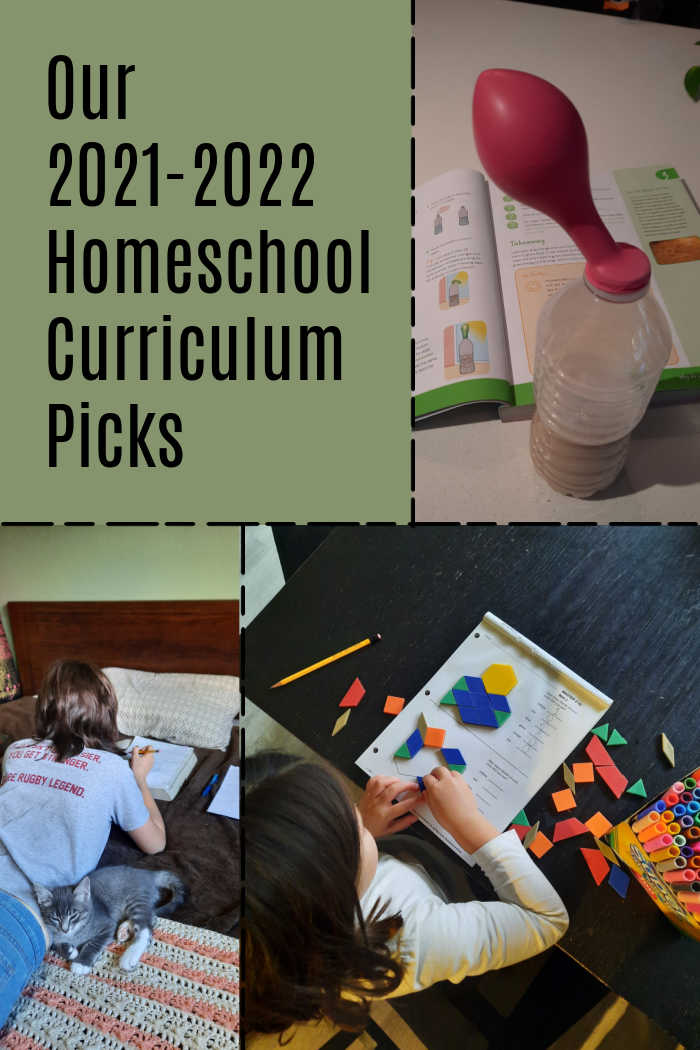
This post contains affiliate links; I earn from qualifying purchases.
Meet the Students
This year, I’ve had three children homeschooling: Lily is working on Grade 7, Jade is working on Grade 3, and Pearl is working on Grade 1/2. (Like Lily, Pearl pretty much skipped Kindergarten and jumped straight into Grade 1 last year. She’s enrolled in Grade 1 with our school but most of her curriculum is at a Grade 2 level.)
Joey has shown great interest in pencils (for walls) and scissors (for making teeny tiny pieces of paper all over the floor) and markers (not usually on paper either) and any read-aloud (with anyone who’ll read to him). I haven’t really done much in the way of preschool activities with him, especially compared to what I did with his sisters in the past, but I’ve tried to follow his interests when he does want to cut, paste, colour or read. He’s also had a lot of fun with his Lovevery preschool play kits, which let him learn while playing (and since he’s very hands-on, this has been perfect).
Homeschool Planner
I spent quite a bit of time researching homeschool planners and getting frustrated with what I found. One planner seemed perfect, as it had everything I wanted and I could even customize quite a few of the pages—and then shipping it to Canada cost more than the planner itself. Some planners didn’t have space for multiple kids and some seemed too expensive or too small.
I finally ended up printing a Catholic Through the Year Homeschool Planner and taking it to a local print shop to have it coil bound. I’ve used it in the past for homeschooling, and they also have a household planner that’s handy. The great thing is that the planners don’t have dates, so I can print it again every year and have a new planner ready to go. Lily coloured the cover for me.
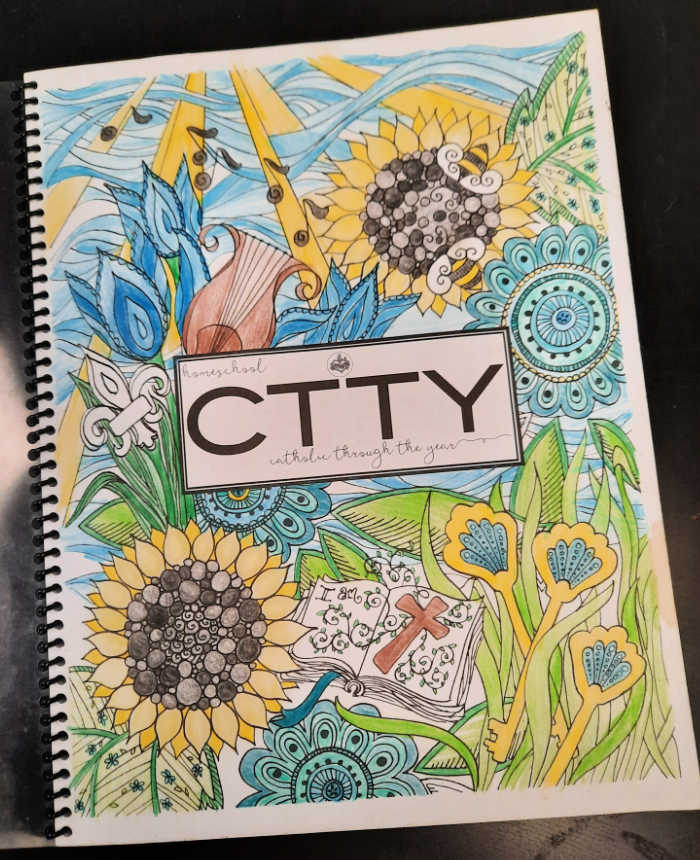
Homeschool Math
Math is one area of curriculum that doesn’t require a lot of thought for me. We use Saxon Math. I currently have Saxon Math books for Kindergarten through Grade 7. Each year, I just reorder the consumable workbooks for the younger grades or pick up graphing square notebooks for the older grades to do their practice problems in. We’ve tried other math curriculum in the past, but I’ve always come back to Saxon as the best curriculum for numerous reasons. Amy from Orison Orchards has a great overview of Saxon Math; someday I’ll get around to writing my own review.
I did have a proud homeschool mom moment this year that also cemented my love of Saxon Math. Math has never been Sunshine’s favourite subject (which is part of why we’ve tried other curriculums in the past). She wasn’t terrible at it; she just didn’t like to do it, so she grumbled and complained and tried to avoid it whenever possible. About a month into Grade 8 at her high school, she came home to show me a math test she’d done. The teacher required all the students to show their tests to their parents and get a signature.
I went over the test with her. She’d gotten one question wrong on the entire test (about twenty questions long), and I quickly saw where she’d made a mistake in her adding that affected the rest of the equation. I discussed it with her, signed it, and handed it back. She said, “Mom, my friends think I’m really good at math.” I looked at her. My I-hate-math-why-do-I-have-to-do-it-can-I-please-just-do-half-the-problems teen just admitted she’s good at math? Yep.
She added, “They want me to help them with their math.” Now, about once a month, she stays late at school to tutor her peers. Because she’s good at math. Like I always told her. So yep, just gonna keep using Saxon Math over here, because she may not have liked it, but she learned it.
Science Curriculum
From Kindergarten until last year, I’ve used Catholic Heritage Curriculum (CHC) science. While it was good, I noticed last year that Sunshine and Lily just weren’t super engaged with the content. They were doing it because it was there, but they weren’t really that interested in what they were learning.
That brought back memories of my own homeschooling experience, plugging through the curriculum year-by-year because the curriculum writer or the government or someone had decided “Thou Shalt Learn This Now.” I got it done… but I didn’t always like it. And I wanted better for my girls. Life is too short to use boring curriculum, I suppose I could say. There are many different areas of science they could study, so why waste so much time learning about an area of science they don’t care about.
(Why am I willing to switch science curriculums and not math? Well, math is math. Every child needs to learn how to do division and multiplication, but not every child needs to learn about robotics or biology or astronomy or botany. If a child is struggling with math, I’d recommend changing curriculum to see if another curriculum can explain it in a way that they understand. My kids have never struggled with math, so changing curriculum in an effort to make it “more exciting” didn’t work. Science, on the other hand, offers numerous areas of study, so why force a kid to learn botany when they’d really prefer astronomy?)
I spent quite a bit of time researching science curriculum and talking to some of my homeschool mama friends about what they’ve used with their kids.
Apologia’s Zoology
For Lily and Jade, I decided to use Apologia. I’ve heard good things about their faith-based curriculum and was able to look over it myself, as my friend had several of the books. The biggest grade gap in my homeschool is between Lily and Jade (four years), so this was the first time I planned curriculum for them to do together. However, out of my kids, they also get along the best, so it made sense to have them work together.
Lily looked over the Apologia website with me, as there’s quite a few different options for science topics at each grade level. She and Jade agreed to do Exploring Creation with Zoology 2: Swimming Creatures. They shared the same textbook, but Lily used the regular notebooking journal while Jade used the junior notebooking journal. Each day, they read the selections in the textbook to each other and then worked on the activities in their journals.
Some of the journal activities are similar in both books, but some are tailored more for each age. For example, Lily’s journal has vocabulary crosswords while Jade’s has colouring pages. Jade’s journal has larger spaces between the lines, while Lily’s journal clearly expects her to write more, whether she’s just jotting notes about her textbook reading or writing an essay or short story.
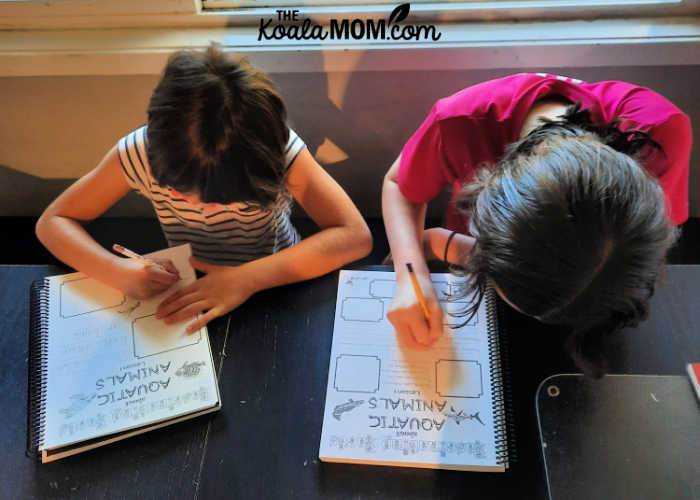
This curriculum has been a huge success. Both Jade and Lily have really enjoyed learning more about sea animals. Zoology 2: Swimming Creatures is a thorough study of the ocean and the amazing creatures who live in it. Words like “cephalopod” are now part of our vocabulary. Because the girls have to work on this together, they’ve done a great job of encouraging (motivating? nagging?) each other to get science done each day. The journals offer a wealth of activities from drawing and writing to making minibooks and other projects that the girls really had fun with.
BookShark Kindergarten
Meanwhile Louise has been learning about insects, reptiles, seeds and weather with BookShark Science. This curriculum is based on 11 fantastic picture books (mostly from Usborne or DK) and includes a weekly, hands-on experiment. Each lesson is short and simple (Pearl can usually do science in 10 or 15 minutes) and yet engaging and interesting. In fact, Joey usually likes to join Pearl for her science lessons and I’ve read most of the books to him more than once.
You might notice that I said Pearl is in Grade 1 this year, but she’s doing Kindergarten Science. Like the Apologia science, the BookShark science kits are grouped around topics for a grade range rather than a specific grade level. Level A (above) is for grades K to 2 and has been perfect for Pearl this year. I think most Kindergarten students would actually find the activity pages a bit hard, as there’s some writing required (and sometimes Pearl still prefers to dictate her answers to me to write).
I’m definitely considering using BookShark science for Jade and Pearl for next year, and may have them look over the book lists with me and see which level most interests them.
Chick Hatching Experience
This spring, we also hatched 3 chicks at home. A local farm supplied us with the equipment and eggs, which we watched for three weeks until the chicks hatched. Then the girls had a week to observe (and play with their chicks) until we sent them back to the farm. This was a lot of fun and lead to quite a few conversations about farm life and raising chickens. The girls really wanted to keep our chicks, but with a move coming up for us this spring, I refused to look up local backyard chicken bylaws. (Maybe next year.)
Social Studies
I also decided to change our social studies curriculum this year. We’ve used RC History for quite a few years now and last year started on our second time through the program. While it’s meant to be repeated every 4 years, at a more advanced level each time, I noticed that my girls were feeling a bit bored with some of the topics. And I was feeling overwhelmed with the planning. While RC History is an amazing program, it also requires a lot of work from the teacher. This year, I wanted something simpler—something open-and-go.
Grade 7: Canadian History
Once again, I discussed topic and curriculum ideas with Lily. When she mentioned doing Canadian history, I knew where to go: Donna Ward. We ordered the Canadian history living books bundle, which included a textbook, four novels, and two picture reference books. Lily has really enjoyed the novels, as well as other books I’ve found for her at our library to add to her studies. Courage & Conquest, the textbook, has a list of books, websites and other resources for each chapter, so your student can dive as much (or as little) as they want into each time period.
Grades 3 and 2: world geography
Jade has been learning about various countries around the world through Tour a Country from CHC. Each month, she creates a travel brochure as she learns about the climate, history, landmarks, and saints of a particular country. The textbook includes lists of resources and suggested topics to study. We’ve found many books (nonfiction and fiction) for her at our library and also frequently use the atlases from our own bookshelves.
Pearl has been using Explore the Continents from CHC. We’ve created a poster for each continent, to which she’s added pictures of native animals, famous landmarks, and Catholic saints. I’ve also found a lot of books for her at the library. Pearl now has a poster of each continent on the wall in our homeschool room and can recognize any continent by its shape. (She’s coloured them all—she should know them!)
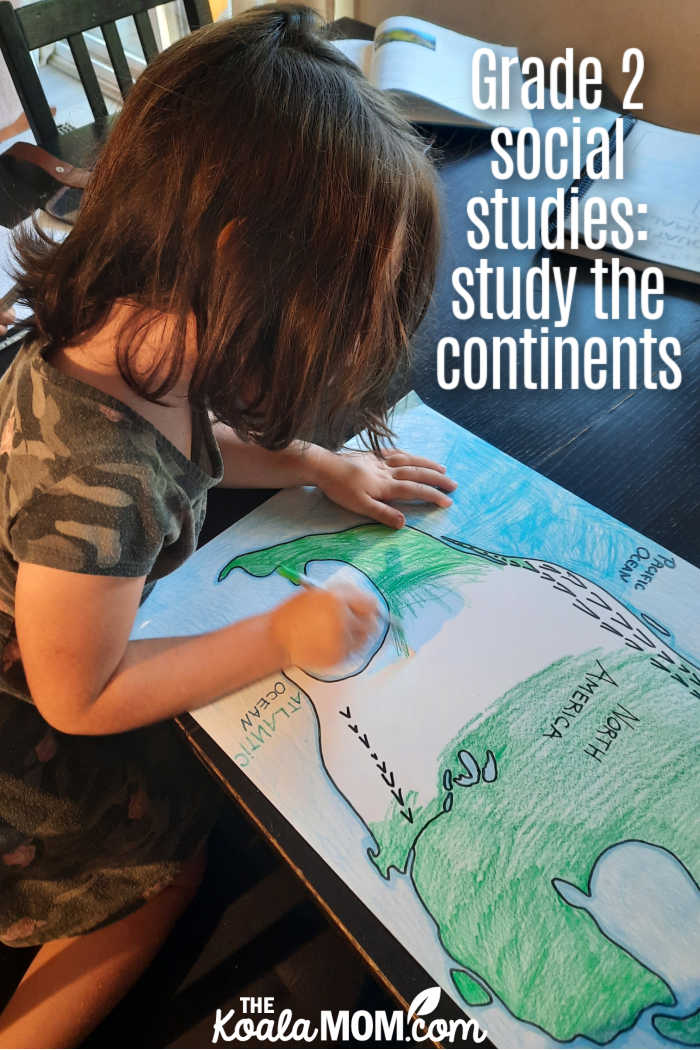
Language Arts
My girls are all avid readers, from Sunshine down to Pearl, so I haven’t been too worried about their reading comprehension.
Lily has been working through the Secret Code of Poetry as well as Stories of the Saints Vol. 3. The first obviously focuses on poetry, unpacking the elements that make up a poem while also encouraging students to read (and memorize and recite) great poetry (including many that I remember from my university English student days). The second contains four longish essays on four different saints, followed by comprehension questions, essay topics, geography suggestions, historical research, and more. Lily found it a bit overwhelming (and boring) to do every question following the essays, so we’ve picked the ones she’s most interested in doing and then moved on.
Jade read through Our Friends From Other Lands, which paired really well with her social studies textbook. Each week, she read a short nonfiction piece about a specific country, and then a longer fictional story about a person in that country. Some of the stories were about fictional people and some were based on real people, usually saints. Following the stories were four or five comprehension questions, which was her least favourite part of the week.
Pearl read Bigger Stories for Little Folks and then Devotional Stories for Little Folks and then Devotional Stories for Little Folks too. These easy readers follow the Petersen family, a mom and dad with three children who are also Catholic homeschoolers (like us!). The stories in the last two books are a bit longer, and the print a little bit smaller, but at the end of each story there are discussion / comprehension questions. Greg, the little boy in the stories, reminds me a lot of Joey (and gives me some hope!). He often had us laughing our way through the stories with his antics. There was also a lot in these stories that was encouraging for me as a homeschool mom.
Each of the girls are also using Language of God and My Catholic Speller from CHC, at their grade level (7, 3 and 2). We usually alternate days on which we do these, so on Tuesdays/Thursdays they do a page in their speller, and on MWF, they do a page in their language books. I’ve found these books to be a fairly comprehensive language arts program that is also easy enough for Pearl to do on her own.
The girls have also all enjoyed using Night Zookeeper, a super fun website that teaches language arts through stories in a mythical zoo. Jade, who writes as little as possible in her reading or science notebooks, was suddenly begging me to be allowed to sit down at the computer and write stories about the Night Zoo. And Pearl, who often dictates answers to me in her schoolwork, was asking me how to spell various words so that she could peck them out on the keyboard to add to her stories.
Second Languages
Lily is continuing to do German via duolingo. Jade has been doing Spanish lessons through an online teacher with Homeschool Spanish Academy, as well as some duolingo practice as well. Her sisters didn’t start a second language until Grade 4, so I wasn’t planning to have her start a language this year either until the opportunity came up to study Spanish. She’s been doing lessons for most of this school year now and still really enjoys chatting with her teacher each week.
Extracurricular Activities
The most exciting part of the homeschool week! Maybe not… it’s also the part that involves me becoming a taxi, and with kids of multiple ages, that’s getting more difficult.
Each of the girls do music lessons. Unfortunately, they each play a different instrument and have different teachers. Lily is continuing her piano lessons at our local arts centre. Jade started guitar lessons this week, online through a local music store. And Pearl is doing group violin lessons, as the local arts centre as well (but of course not on the same day as Lily’s piano lessons).
Lily did swim lessons in January. She and Jade are now starting the track and field season through a community league.
We continue to be active with our local homeschool community, and have enjoyed a few field trips and other activities this year as the pandemic has eased and people have been more comfortable with gathering. We are looking forward to that trend continuing through the summer.
You can also check my homeschool curriculum choices for the past several years:

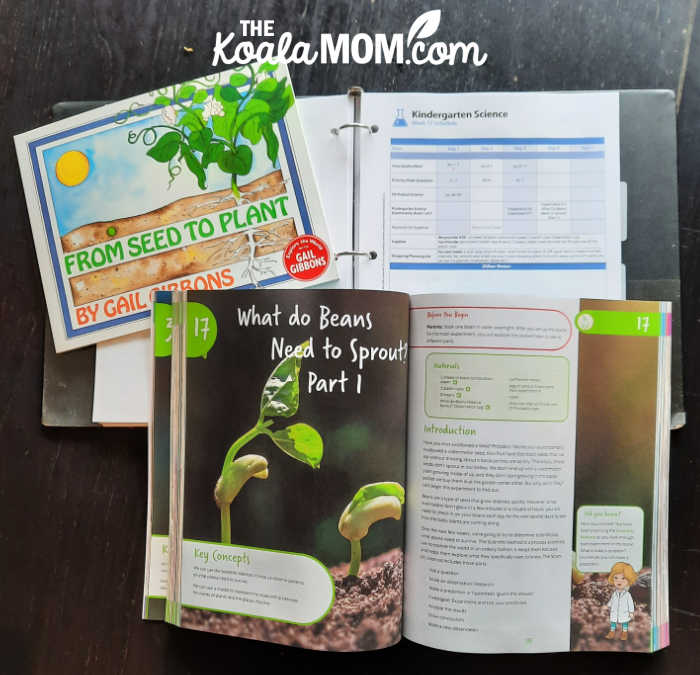
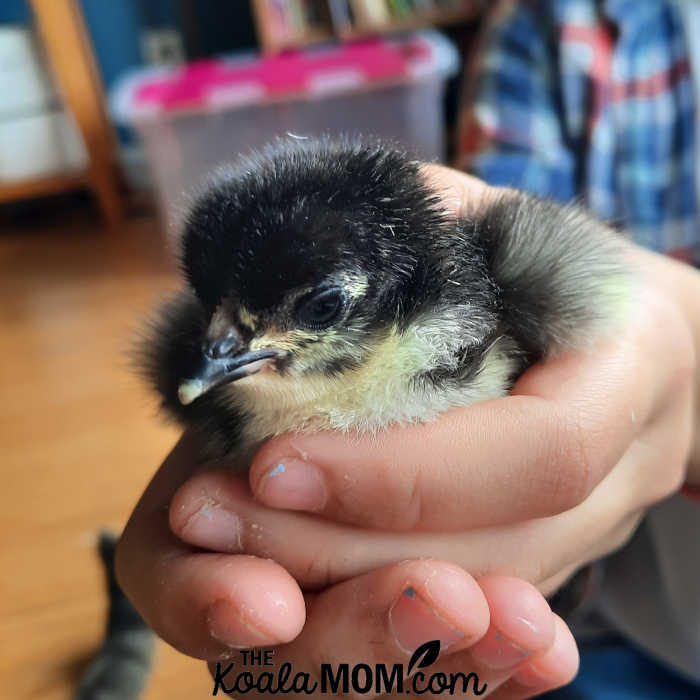
No Responses Yet